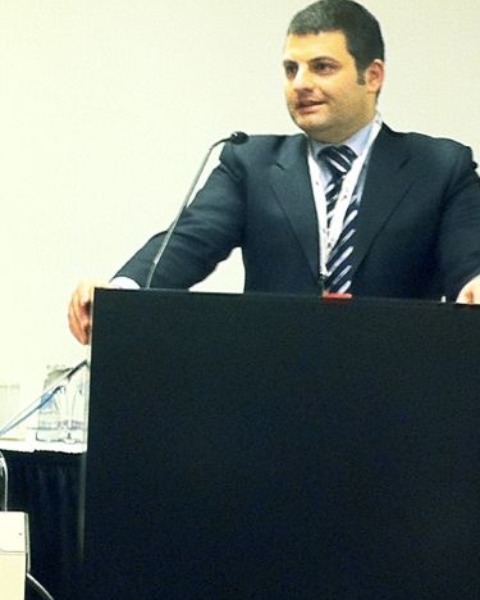Back
Poster, Podium & Video Sessions
Moderated Poster
MP05: Stone Disease: Basic Research & Pathophysiology
MP05-08: Possible role of the microbiota in urinary stones: a prospective study to correlate radiological density (Hounsfield Units) and cultural examination of urinary calculi
Friday, May 13, 2022
8:45 AM – 10:00 AM
Location: Room 225
Antonio Luigi Pastore*, Andrea Fuschi, Yazan Al Salhi, Alessia Martoccia, Lorenzo Capone, Silvio Scalzo, Paolo Pietro Suraci, Onofrio Antonio Rera, Fabio Maria Valenzi, Alice Antonioni, Antonio Carbone, Latina , Italy

Antonio Pastore, MD,PhD
Sapienza University of Rome
Poster Presenter(s)
Introduction: The aim of the study is to evaluate a possible correlation between the hardness of the urinary stone expressed in Hounsfield Units and the bacterial contamination by cultural examination of the lithiasic fragments obtained after endoscopic treatment (ureteral lithotripsy and retrograde intrarenal surgery).
Methods: This prospective study investigated patients with unilateral urinary lithiasis (ureteral and / or renal) who underwent endoscopic lithotripsy between January 2020 and March 2021. All patients were studied preoperatively with Uro-CT scan, measuring the Hounsfield Units, the number and size of the calculi for each patient. Two lithiasic fragments were extracted at the end of each procedure (one from the core and one from the periphery of the stone) and sent for chemical-physical and cultural examination.
Results: 73 patients were enrolled and studied prospectively. 56 submitted to ureteral Holmium Yag Laser lithotripsy and 17 to RIRS. The chemical-physical evaluation showed 92% of the stones made up of calcium oxalate, 4% of calcium phosphate, 2% of uric acid and 2% of various composition. The bacterial analysis of the fragments showed a positive culture in 68% of cases, with positive Staphylococcus Epidermidis in 46% of cases, Proteus Mirabilis in 24%, Escherichia Coli in 23% and 7% with other microorganisms. The correlation between stone core culture and formation HU was statistically significant, with Staphylococcus Epidermidis associated with a mean Hounsfield value of 1234 HU; Proteus Mirabilis with average Hounsfield 872 HU; Escherichia Coli with mean Hounsfield 642 HU (p values <0.0001). The mean radiological density in the negative culture urinary stones was 843 HU.
Conclusions: Our study demonstrates a statistically significant correlation between urinary stone infection and its radiological density (HU). We postulate that the correlation between the stone core isolated microorganism and the calculi hardness (HU) might impact on the treatment choice and results (stone free rate).
Source of Funding: None.
Methods: This prospective study investigated patients with unilateral urinary lithiasis (ureteral and / or renal) who underwent endoscopic lithotripsy between January 2020 and March 2021. All patients were studied preoperatively with Uro-CT scan, measuring the Hounsfield Units, the number and size of the calculi for each patient. Two lithiasic fragments were extracted at the end of each procedure (one from the core and one from the periphery of the stone) and sent for chemical-physical and cultural examination.
Results: 73 patients were enrolled and studied prospectively. 56 submitted to ureteral Holmium Yag Laser lithotripsy and 17 to RIRS. The chemical-physical evaluation showed 92% of the stones made up of calcium oxalate, 4% of calcium phosphate, 2% of uric acid and 2% of various composition. The bacterial analysis of the fragments showed a positive culture in 68% of cases, with positive Staphylococcus Epidermidis in 46% of cases, Proteus Mirabilis in 24%, Escherichia Coli in 23% and 7% with other microorganisms. The correlation between stone core culture and formation HU was statistically significant, with Staphylococcus Epidermidis associated with a mean Hounsfield value of 1234 HU; Proteus Mirabilis with average Hounsfield 872 HU; Escherichia Coli with mean Hounsfield 642 HU (p values <0.0001). The mean radiological density in the negative culture urinary stones was 843 HU.
Conclusions: Our study demonstrates a statistically significant correlation between urinary stone infection and its radiological density (HU). We postulate that the correlation between the stone core isolated microorganism and the calculi hardness (HU) might impact on the treatment choice and results (stone free rate).
Source of Funding: None.

.jpg)
.jpg)